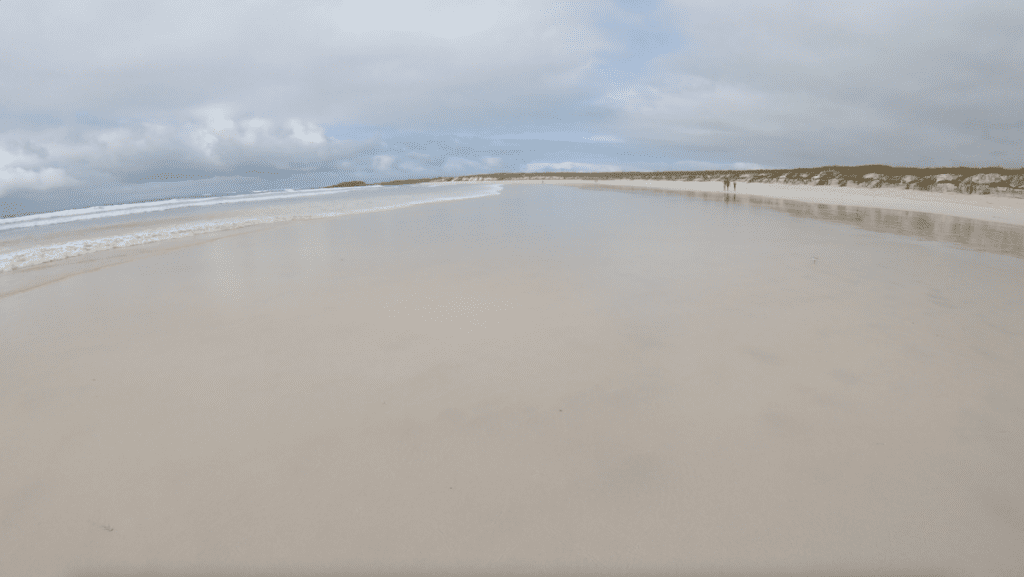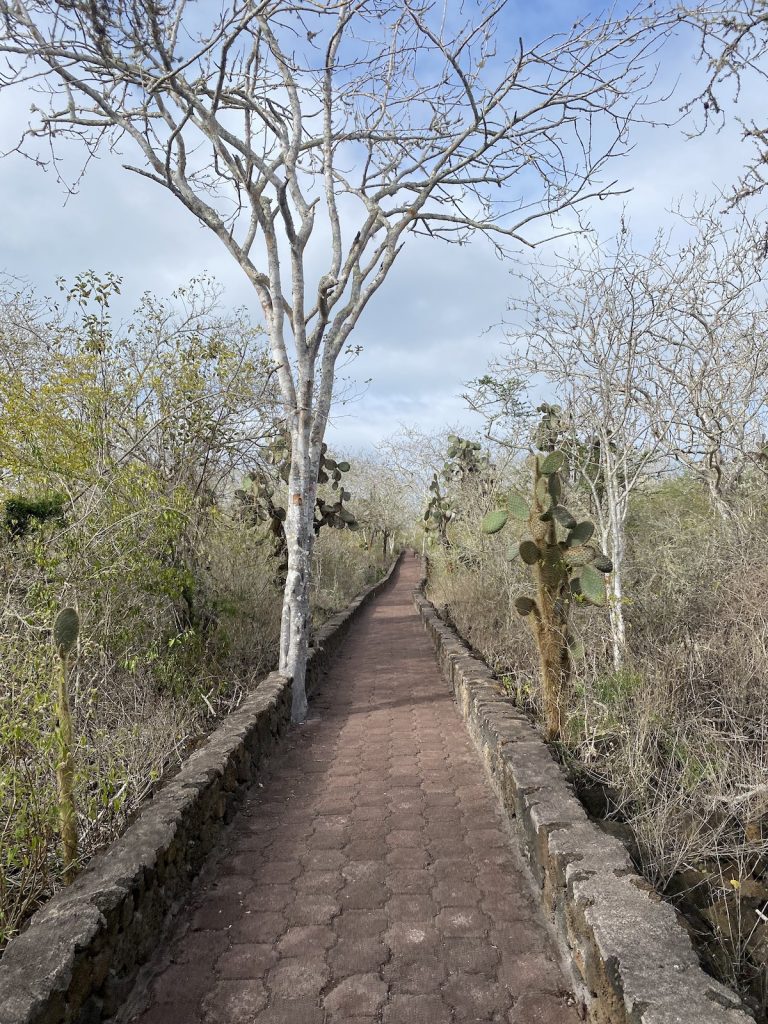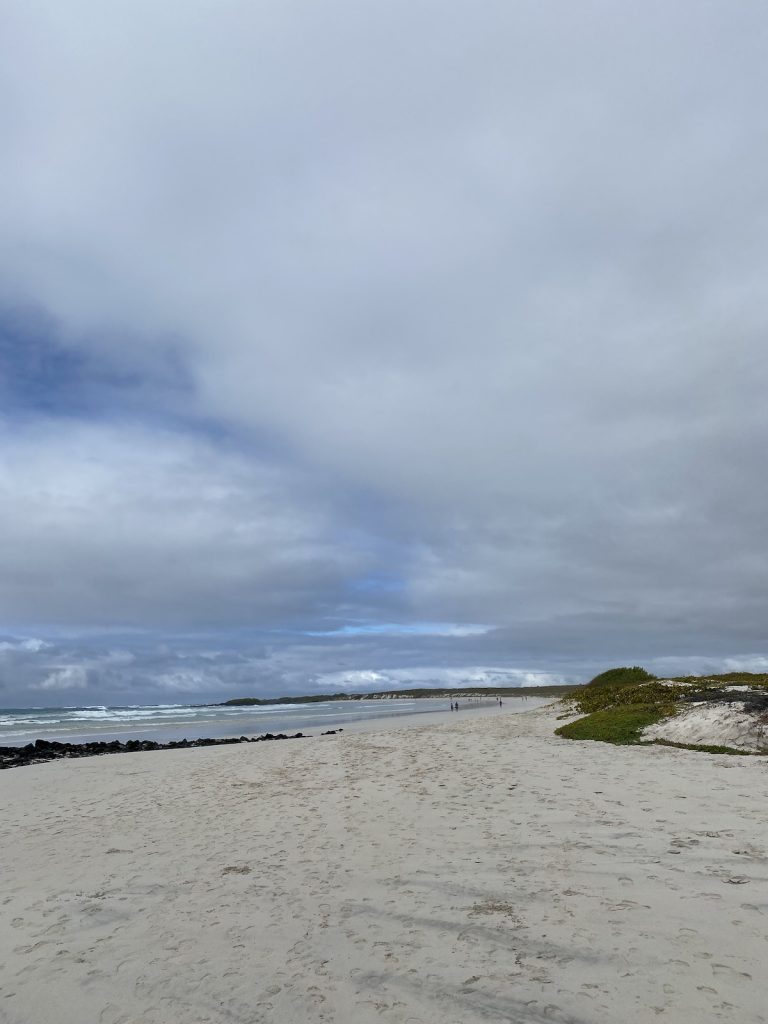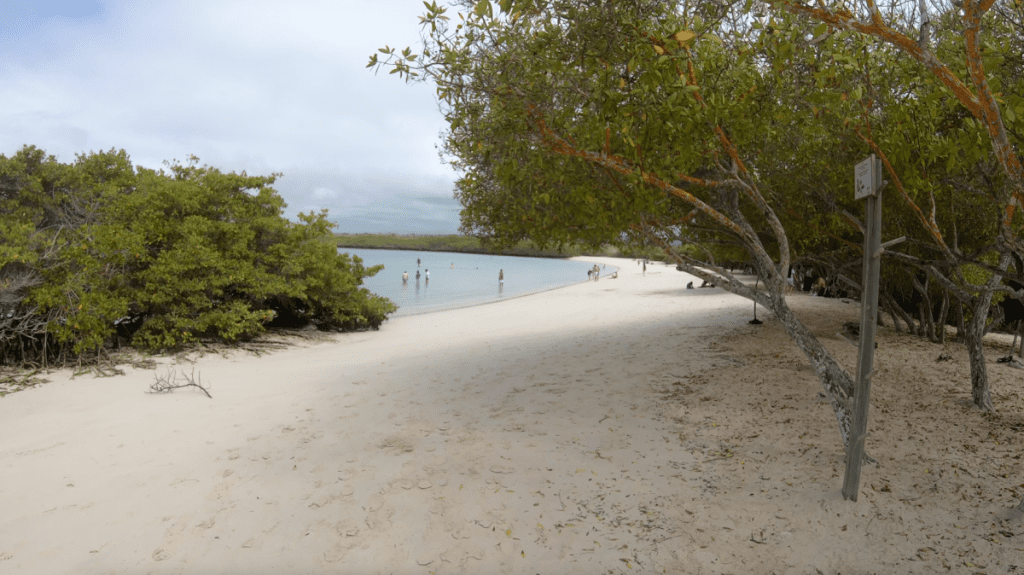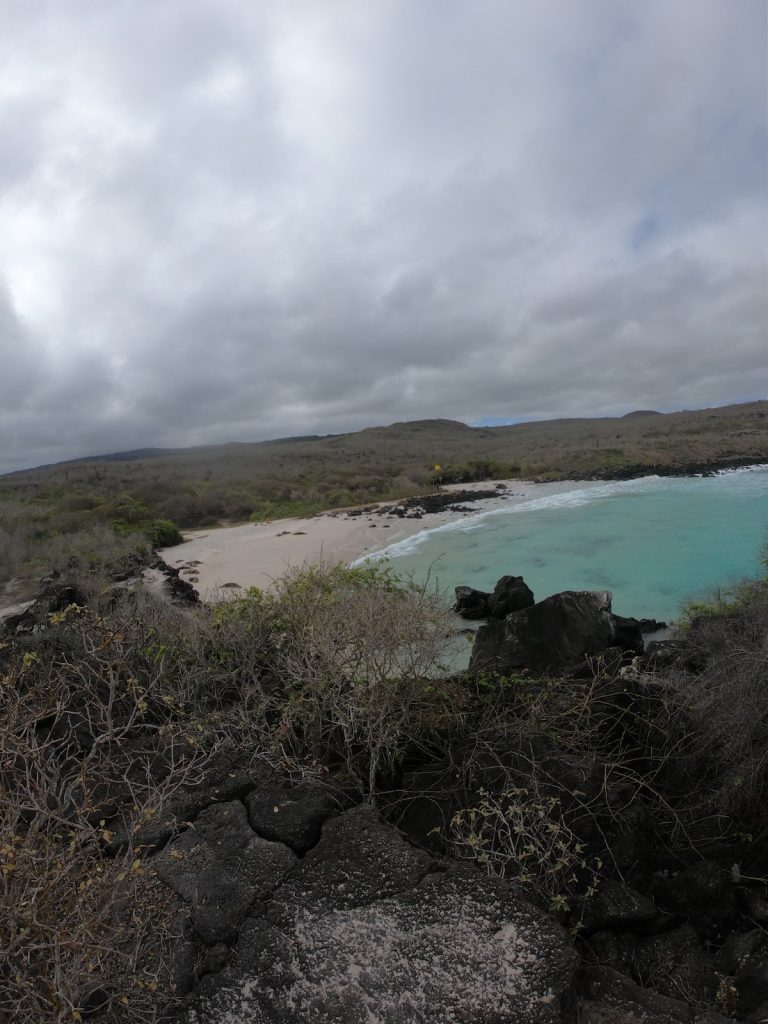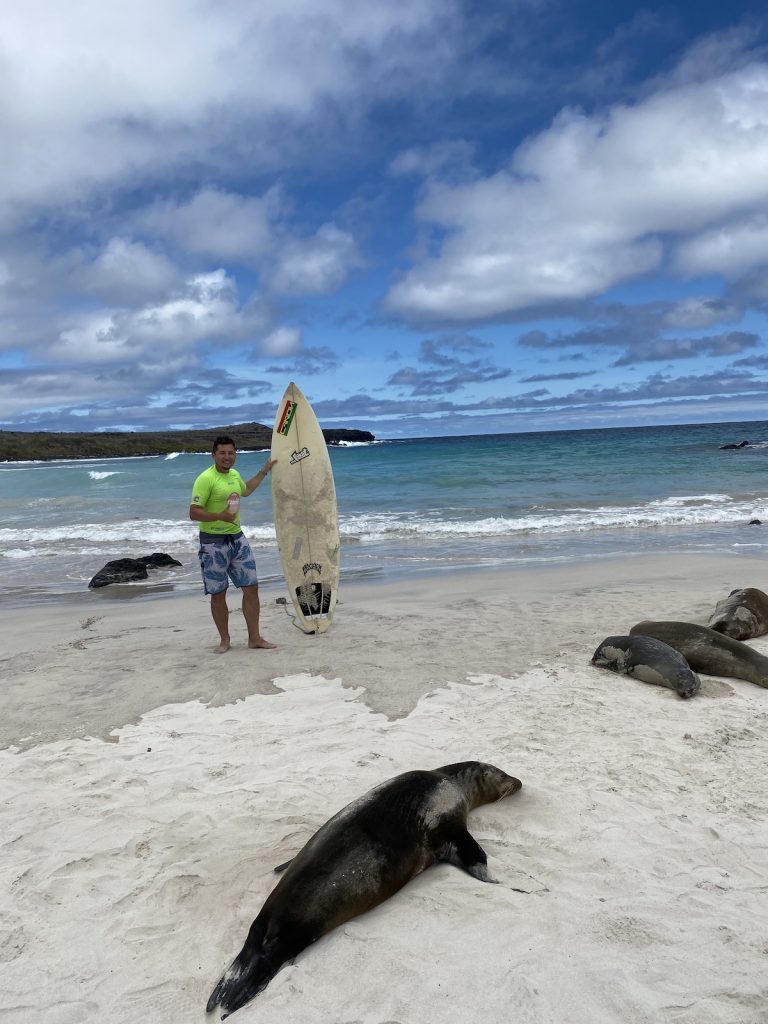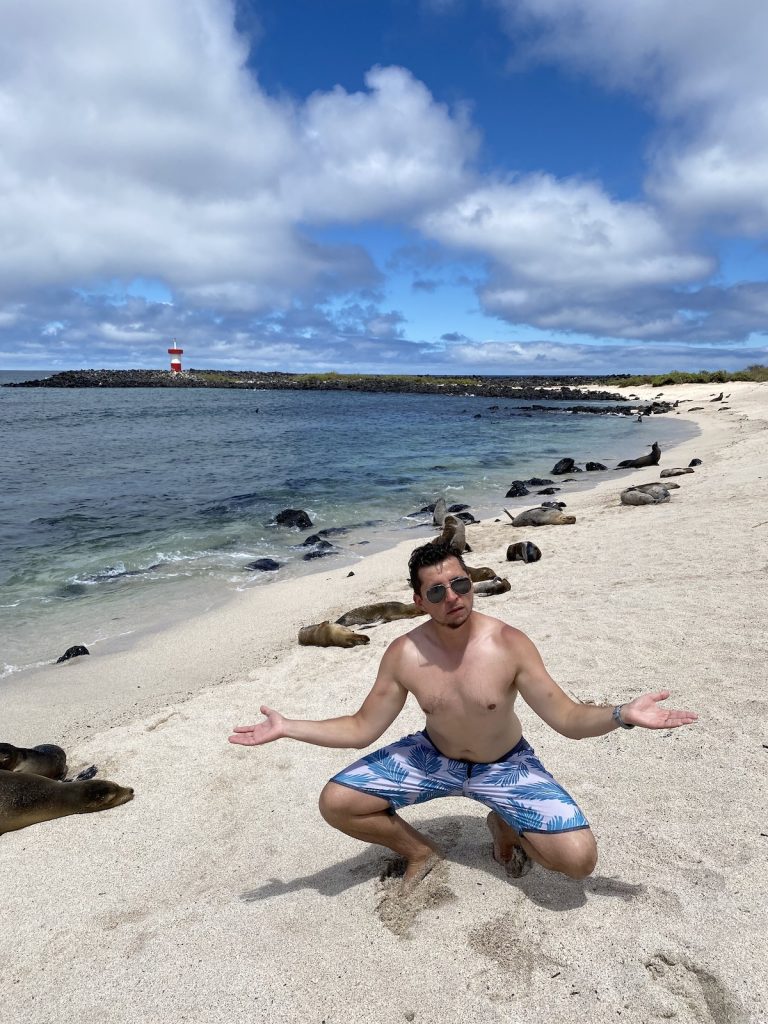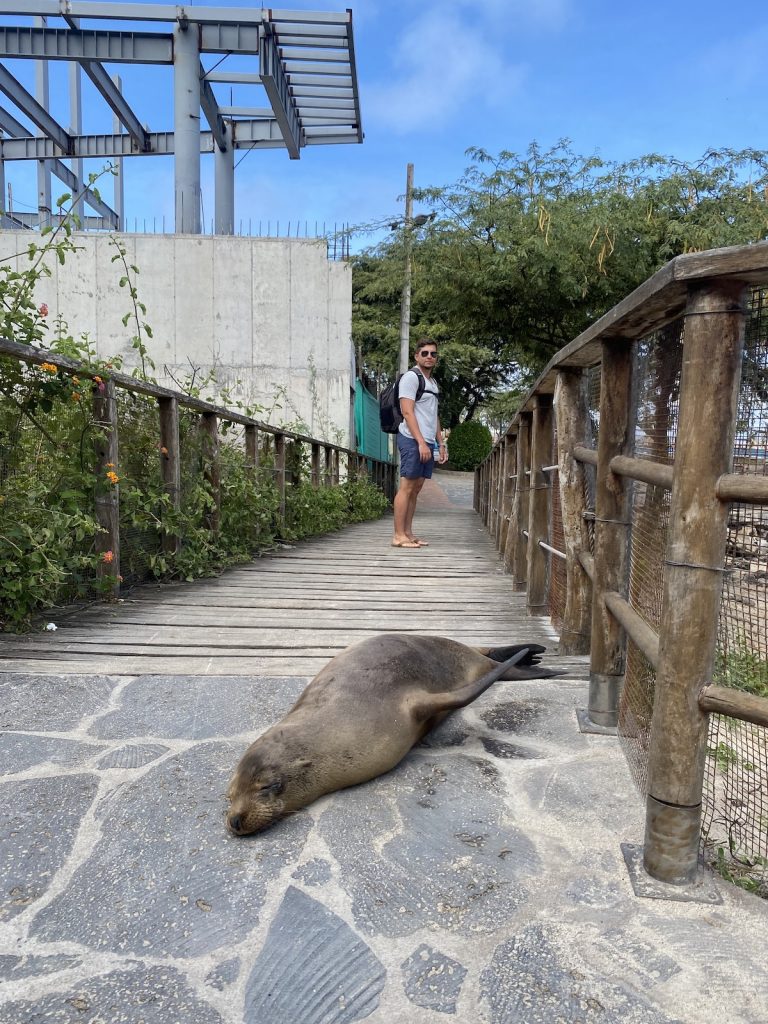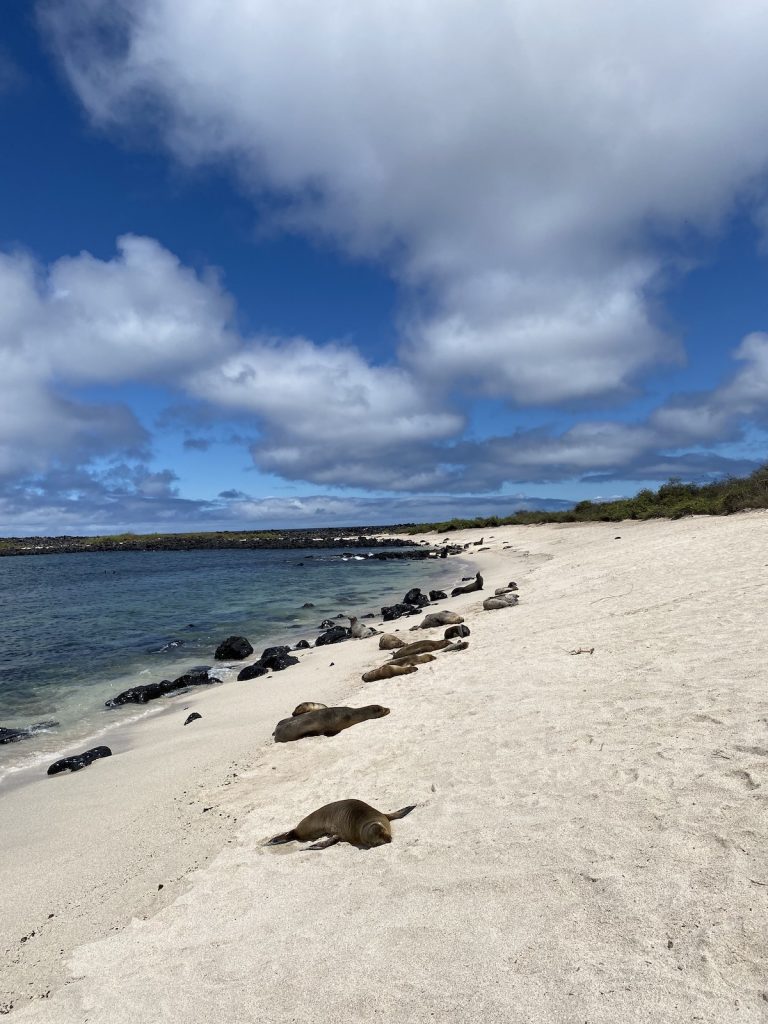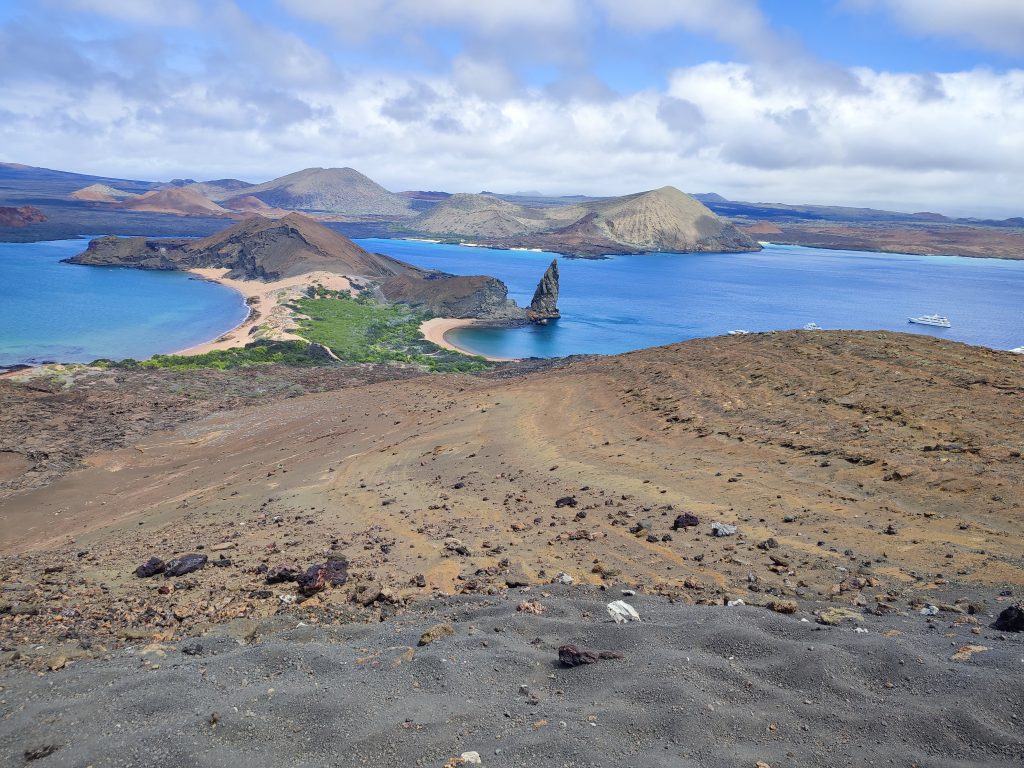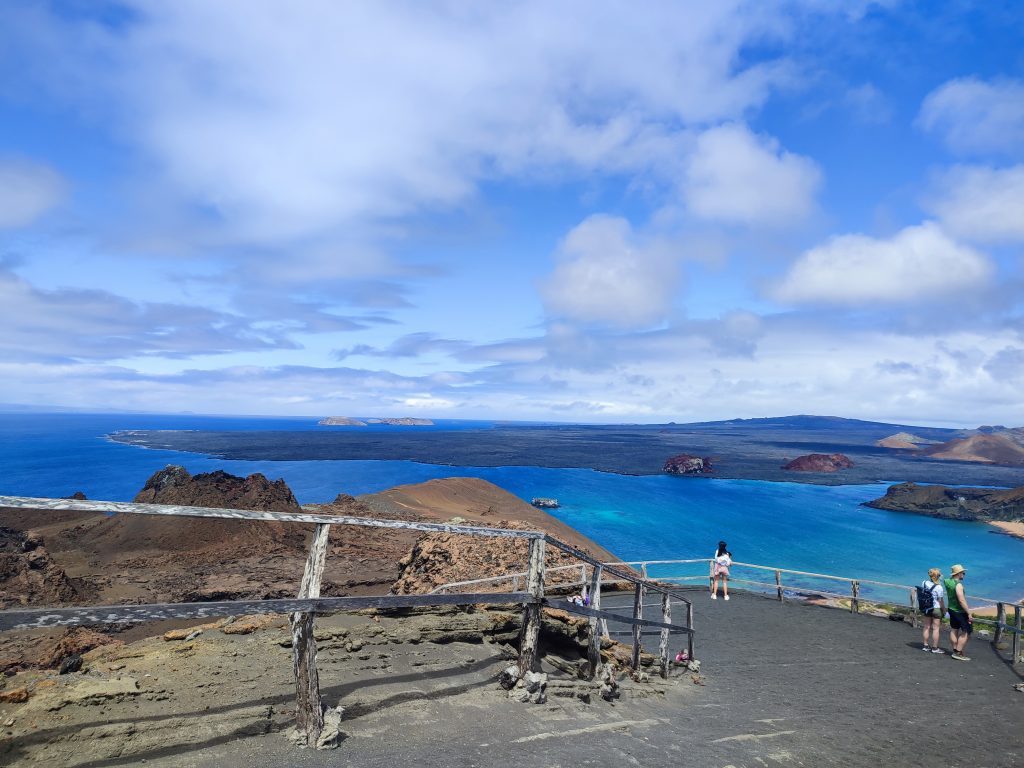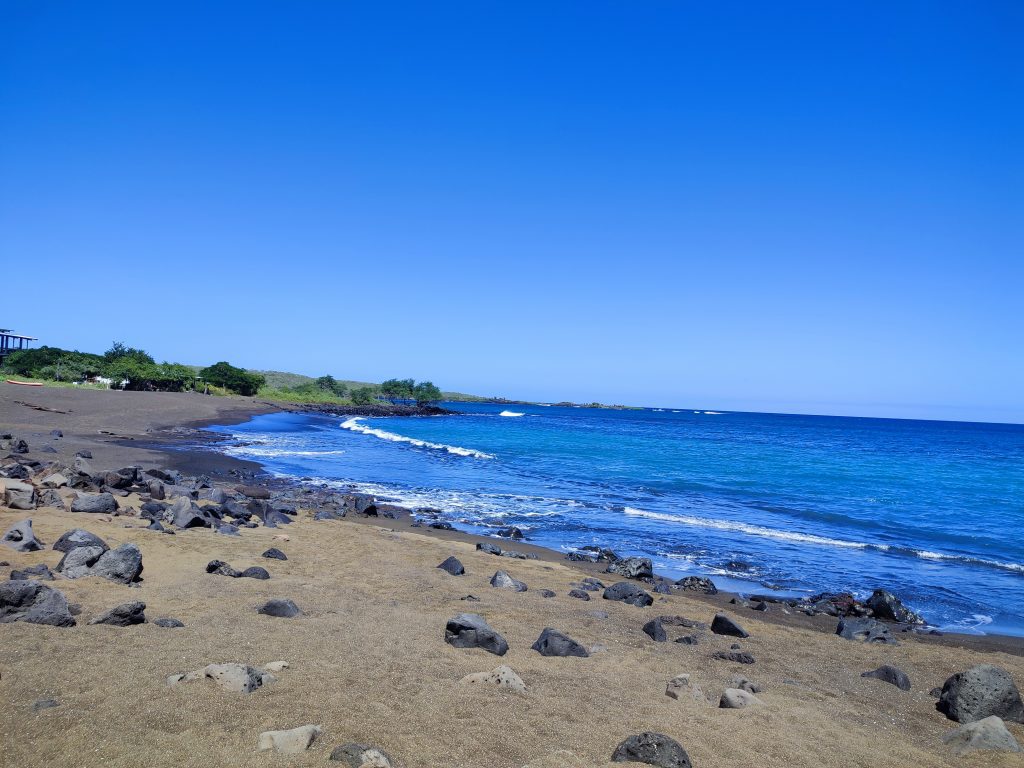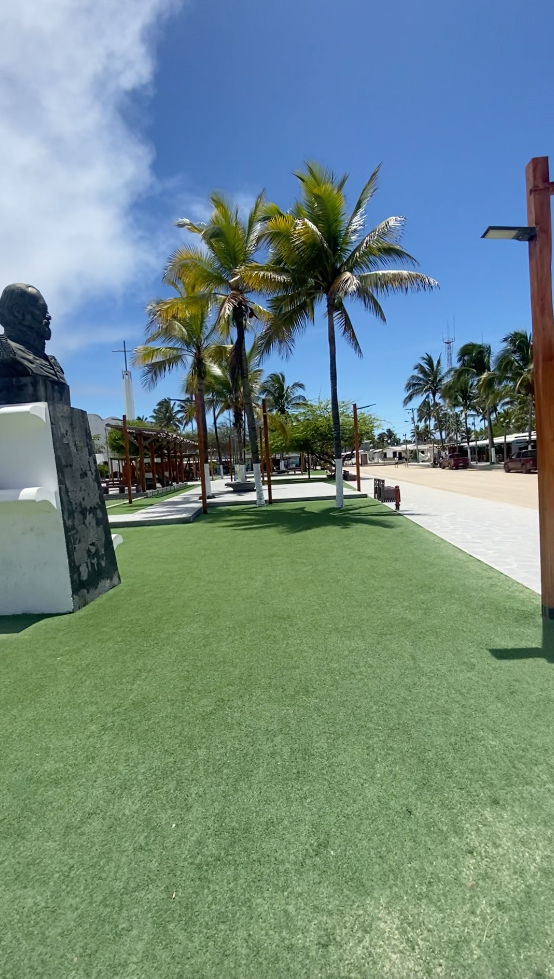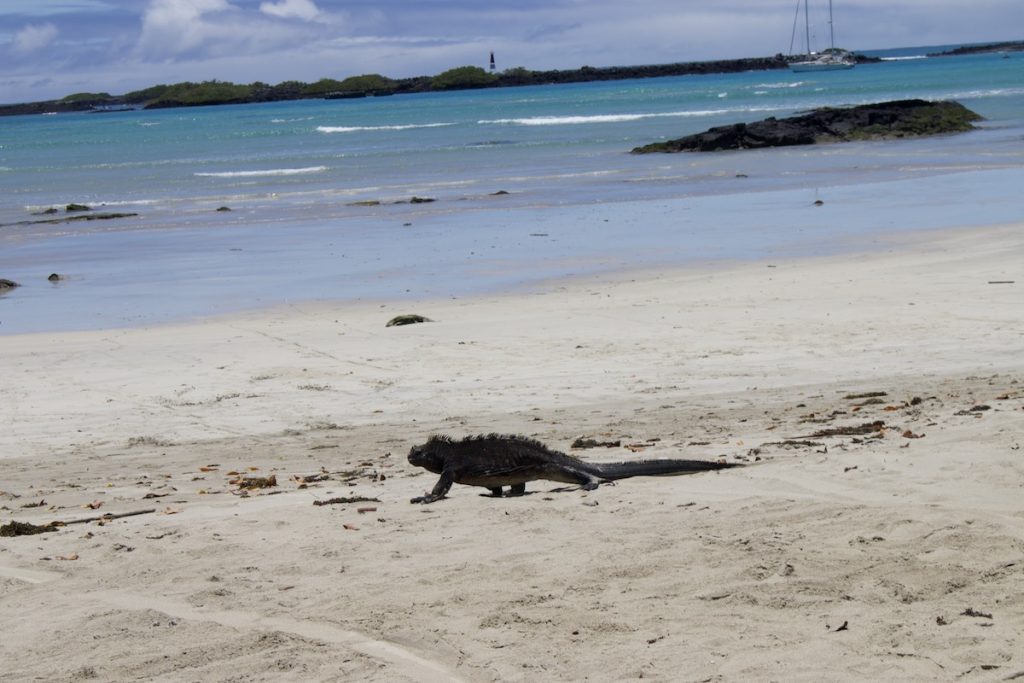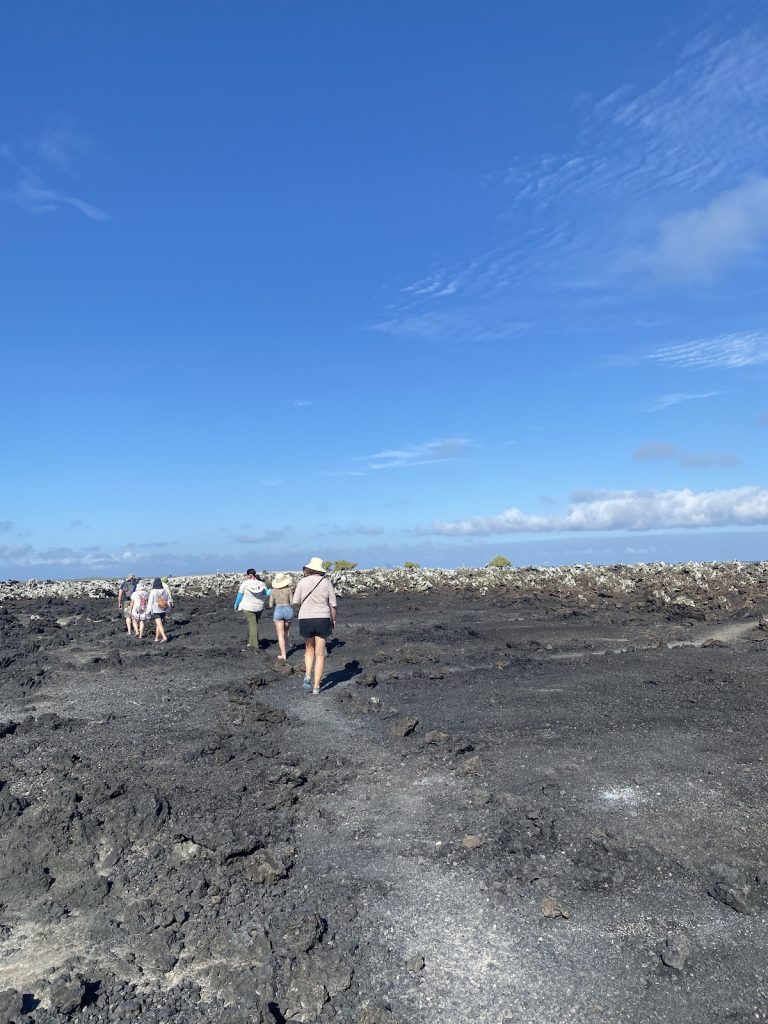Plan perfect trip to Ecuador & Galapagos
I spent countless hours researching everything about traveling to Ecuador, and I created this blog for fellow travel enthusiasts who want the best, most reliable information. But if you want to save time, we’ve partnered with the top local agency to plan your dream trip.
Tortuga Bay (Bahia Tortuga)
Tortuga Bay is located on Santa Cruz Island, Galapagos. It is a perfect area to relax and enjoy traditional beach activities surrounded by intriguing Galapagos wildlife.
How To Reach Tortuga Bay
Tortuga Bay is a beautiful destination just an hour’s walk from Puerto Ayora, and for those who love exploring on foot, it’s a fantastic path. The 1.5-mile (2.5-kilometer) trail starts at the main water taxi port and leads you through lush landscapes. Along the way, we had the chance to see colorful warblers, finches, and even some playful mockingbirds. A lava lizard also dashed across our path, adding to the excitement.
For anyone not in the mood to walk, a water taxi from Puerto Ayora can take you there for about $10, offering a quick and scenic way to reach this gem of a beach.
Activities in Tortuga Bay
Tortuga Bay is perfect for relaxing, sunbathing, kayaking, and just strolling along the stunning shoreline. We found it a fantastic spot to unwind and take in the beauty around us. Swimming at the main beach isn’t allowed due to strong currents, but a nearby sheltered cove offers a safe spot for swimming. This little cove was a highlight for us, providing calm waters for a refreshing dip and a bit of snorkeling.
Our time at Tortuga Bay was well spent exploring the tranquil waters of Playa Mansa beach, where we swam and snorkeled to our hearts’ content. Birdwatching was another delightful surprise, thanks to the incredible variety of bird species in the area. My wife and I were lucky enough to spot pelicans and finches up close, and we even caught sight of a couple of flamingos gracefully wading in the salt lagoon nestled back into the mangroves. These moments added a peaceful and unique charm to our Tortuga Bay experience.
Puerto Chino
Puerto Chino is a beautiful little gem tucked away on the opposite side of San Cristobal Island from Puerto Baquerizo Moreno. This small cove felt like a peaceful retreat, offering a perfect spot to relax, soak in the scenic views, and listen to the waves of the Pacific Ocean. We found it to be an ideal place to escape, unwind, and just enjoy the untouched beauty of the Galapagos.
How To Reach Puerto Chino
If you’re up for it, you could walk or bike the 24 kilometers (around 15 miles) to Puerto Chino Beach. But we decided to take a taxi, which cost us about $40 for both directions. We arranged with the driver to pick us up in the afternoon, so we had plenty of time to enjoy the beach. The taxi dropped us off at the trailhead, and from there, we set off on a gentle 15- to 20-minute walk to the beach. The flat terrain made it accessible for everyone, and the stroll itself was quite enjoyable. We even spotted a few birds and a Galapagos lizard scurrying along the path, making the journey feel even more connected to the island’s unique wildlife.
Activities in Puerto Chino
As we reached the end of the trail, a line of trees opened up to reveal Puerto Chino’s stunning white sand beach. We were immediately taken by the beauty of the place, a perfect spot for swimming, snorkeling, or even surfing if you’re up for it. Puerto Chino is known to be one of the few beginner-friendly surfing beaches in the Galapagos, which makes it even more inviting.
We found a nice spot to settle down and took some photos to capture the scenery around us—soft white sand, patches of lava rock, tranquil blue water, and a small hill covered in lava rock and bushes to the right. One local we spoke to shared that the cove’s name, “Puerto Chino,” came from that hill, which resembles a Chinese hat. We spent a few peaceful hours here, snorkeling and admiring the curious sea lions that swam by and the occasional bird flying overhead. The whole experience was truly unforgettable.
Playa Mann
Playa Mann beach quickly became one of our favorite spots on San Cristóbal Island, and it’s easy to see why it’s such a beloved place for the locals. Just about 650 meters north of the village of Puerto Baquerizo Moreno, Playa Mann sits right in front of the San Cristóbal Interpretation Center.
Its easy access from town and beautiful setting made it the perfect spot to relax. We loved having such a fantastic beach so close, and it gave us the chance to see how locals enjoy this natural gem just as much as visitors do.
How To Reach Playa Mann
Reaching Playa Mann is a breeze, whether on foot or by taxi. It’s just a 10-minute walk north from downtown Puerto Baquerizo, so we decided to stroll over, enjoying the chance to take in more of the area. Visiting the beach before noon was perfect—the peaceful walk added to the anticipation, and by the time we arrived, we were already feeling immersed in the laid-back island vibe.
Activities in Playa Mann
Playa Lobería
Have questions about your upcoming Galapagos trip? Join my Galapagos Reddit community and ask other travelers who recently visited the islands. Get up-to-date tips, real experiences, and honest advice from other travelers (I ban tour agencies and resellers).
Playa Loberia once lived up to its name, “Sea Lion Beach,” with an impressive sea lion population. In the past, this was the go-to spot for seeing these playful creatures up close. However, things have shifted, and now many sea lions have made their way over to Playa de Los Lobos instead.
It was interesting to hear about this change from the locals. It shows how even wildlife on the islands has its own ebb and flow, moving from one place to another over time.
How To Reach Playa Loberia
La Lobera is easily accessible by foot, cab, or bicycle, with taxis from town costing about $2 to $3 for a quick 10-minute ride. For those feeling a bit more adventurous, a 15-minute bike ride or a leisurely 45-minute walk is also a great option.
From the trailhead, me and my wife took a short 10-minute walk to the beach. Along the way, we spotted one of the largest iguanas I’d ever seen and a few horse flies buzzing about. The path wound through a small grove of trees, and as we emerged, the rocky beach of La Lobera stretched out before us. It was a striking sight, with the rugged coastline giving it a uniquely wild feel.
Activities in Playa Loberia
Playa Loberia turned out to be a fantastic snorkeling spot, and it’s great even for families. The water was so clear and calm, creating a safe haven perfect for kids or anyone just wanting to float and take it easy.
For those seeking more adrenaline, the beach has some impressive surf breaks due to the rocks lining the shore. Watching surfers catch waves against the rocky backdrop was quite the sight, and I could see why they’re drawn to this spot.
While it’s tempting to get up close to the curious sea lions, we kept our distance, especially since they can sometimes be unpredictable. Instead, we enjoyed observing them from afar, soaking in the beach’s wild ambiance. Besides the sea lions, we were lucky to spot some frigate birds soaring above, finches hopping around, and even a few marine iguanas sunning themselves on the rocks. Playa Loberia is a special place that brings you close to Galapagos wildlife while still keeping that untamed, natural feel.
Pinnacle Rock Beach
Pinnacle Rock on Bartolome Island is one of those iconic sights that everyone talks about in the Galapagos. This towering volcanic cone, formed from layers of cooled lava, is a true natural marvel. It’s fascinating to think about how it was shaped — lava pouring from an underwater volcano, cooling rapidly in the sea, and then morphing into the layered basalt structure that it is today.
Though we didn’t get to visit Pinnacle Rock because of an unexpected boat mishap, everyone we met who’d been there had incredible stories to share. The beach around Bartolome Island, with its clear waters and unique rock formations, sounds like a must-see for anyone visiting the Galapagos. We’re hoping to make it back someday to experience it for ourselves!
How To Reach Pinnacle Rock Beach
Activities in Pinnacle Rock Beach
Bartolome Island is a dream for photographers, with its incredible views and Pinnacle Rock as the perfect backdrop. Most visitors make the hike up to the Pinnacle Rock Viewpoint for panoramic shots, and from what we’ve been told, it’s worth every step. The viewpoint is known for sweeping views of the island’s diverse birdlife and playful sea lions down below.
The beach itself offers so much for anyone who loves the ocean—swimming, snorkeling, and diving, or simply relaxing on the golden sands. We had been excited about diving here ourselves, imagining the vibrant marine life and clear waters, but that adventure will have to wait until our next visit.
Puerto Villamil’s Main Beach
Puerto Villamil beach on Isabela Island is truly a slice of paradise—a stunning 4km stretch of soft, white sand and calm, turquoise waters that seem to go on endlessly along the seaside. It’s perfect for unwinding and catching a breather after days of island hopping and adventures.
We found it an ideal spot for quiet reflection and soaking up the peaceful surroundings, with the gentle ocean breeze and soft sound of waves as our background. For anyone looking to take it slow and simply enjoy the beauty of the Galapagos, this beach is the place to be.
How To Reach Puerto Villamil’s Main Beach
Puerto Villamil’s main beach is incredibly accessible, sitting right in front of the town that feels like the “heart” of Isabela Island. Being the primary beach on the island, it’s a go-to spot for locals and travelers alike.
We made our way there on foot—it’s only about a 500-meter walk if you’re not staying at one of the beachside hotels. The short 15-minute walk from downtown felt like part of the experience, taking in the town’s laid-back vibe as we strolled toward the inviting stretch of sand.
Don’t leave your Galapagos beach adventures to chance! Get a FREE tailored itinerary that combines breathtaking beaches, exciting activities, and ideal accommodations. Your booking not only guarantees a hassle-free trip but also supports local businesses and keeps this blog alive.
Activities in Puerto Villamil’s Main Beach
Puerto Villamil’s beach turned out to be a snorkeling gem, especially with the presence of Galapagos sea lions lounging right on the shore. We had initially considered skipping the snorkeling due to some post-tour exhaustion, opting instead to relax on the sand and just soak in the scenery. But the sight of pelicans diving for fish quickly changed our minds; if they were getting lucky with the day’s catch, we figured we might, too!
The water was calm and inviting, and once we got in, we were rewarded with the lively sights of colorful tropical fish darting around and even a few turtles gliding gracefully below. Watching the sea lions float and relax nearby while marine iguanas sprawled on the rocks only added to the experience. Some locals mentioned that penguins sometimes make an appearance on the rock outcrops or in the cooler waters. We didn’t spot any this time, but that gives us another reason to come back.
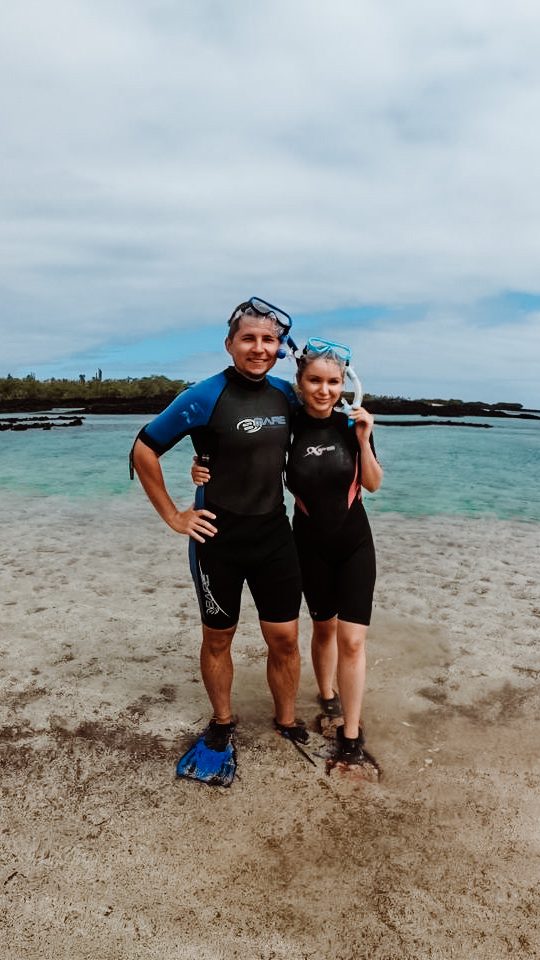
Planning trip to Galapagos Islands?
My wife and I spent two weeks on these magnificent islands, visited nearly every possible tour, and explored as much as we could. I shared all the important details in my comprehensive Galapagos Islands Travel Guide, where I cover everything you need to know about planning a trip to the Galapagos.
Galapagos Islands travel might surprise you with extra fees to enter the islands, the complicated logistics between islands, booking tours, and knowing which spots are free to explore and which ones are not. I’ve covered it all in this Galapagos Travel Guide.
Also, if you’re planning a trip to the Galapagos, make sure to use my link for discounted hotel prices via Booking.com. It really helps support my blog!
Conclusion
The beaches of the Galapagos are truly something to savor — each one is pristine and beautiful, with wildlife and landscapes that feel almost otherworldly. If you’re heading to these shores, get ready for some unforgettable scenes. It’s worth snapping as many photos as you can, but also take the time to soak it all in.
Whether you’re into thrilling water adventures or prefer to lounge on the sand under the warm sun, the beaches in the Galapagos will leave you in awe. Every beach here has its own charm, and exploring them is a must for any nature lover or adventure seeker.
Plan perfect trip to Ecuador & Galapagos
I spent countless hours researching everything about traveling to Ecuador, and I created this blog for fellow travel enthusiasts who want the best, most reliable information. But if you want to save time, we’ve partnered with the top local agency to plan your dream trip.


